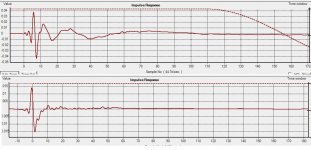 I put these two together as classic examples of highly different impulse responses even though the frequency responses of both are pretty good. In the top one the non-minimum phase aspect is obvious. Both have a LP filter at 12 kHz because the bottom one have a strong resonance at 15 kHz which causes a large ripple in the impulse which obscures what I am trying to show. You can still see the ripples slightly. The pre-ripple is from the digital filter in Holm.
I put these two together as classic examples of highly different impulse responses even though the frequency responses of both are pretty good. In the top one the non-minimum phase aspect is obvious. Both have a LP filter at 12 kHz because the bottom one have a strong resonance at 15 kHz which causes a large ripple in the impulse which obscures what I am trying to show. You can still see the ripples slightly. The pre-ripple is from the digital filter in Holm.An ideal impulse would be a large first peak followed almost immediately by a negative peak of almost the same amplitude, but this second peaks would tail off with a very long ripple indicating its HP function. In the second one there is a small aberration from the cabinet at about 50 samples. But the bottom curve is far better than the top one as far as a compact impulse response goes.
Last edited:
The term darkness is not well defined. A tweeter that disperses widely will have a directivity based gain via the walls and it will sound louder than one with a greater direct to reflected ratio. The latter will sound cleaner when adjusted for correct direct sound, but also have a relatively 'darker' presentation level wise.
I haven't read all this thread so it may have been mentioned already but I can recall a parallel or similar situation in number of amplifier reviews that comment favorably on "inter transient silence" (their term not mine). One was from a Mosfet power amp' in the old Wireless World. I think in this case it is a lack of inter-modulation distortion and probably the high stability and clean square waves that people like John Linsley Hood valued so much.
Jonathan
Jonathan
You're right on the money, fpitas. That low-level "hash" is indeed low-level distortion which infects most replay - and for the majority of systems is difficult to eradicate; hence the tremendous level of fiddling with loudspeaker technology, in an attempt to disguise or mitigate the subjective impact of these artifacts.I think you're heading in the right direction with negative space. Once I got used to the new sound, it became obvious that some kind of low-level "hash", which I hadn't realized was present, was now gone; and as I said, low-level details became far more audible. In fact, I listen at lower levels than I used to, yet hear everything as well.
Now you've got to this point the door is wide open - that quality you're now seeing can be improved and improved upon, almost without limit - if you continue along the same lines in the way you're approaching the tweaking ...
Guys I love these terms: "negative space" and "inter-transient silence". they are right on the topic. these are the same things different people are bringing up when reaching for term "darkness" as a key to speaker clarity. (btw not the venue or room effects: read on Siegfried's site for his full description).
The industry has to start looking at testing speakers with more sophisticated test signals that get us at least an inch closer to what the drivers will be seeing when playing actual music. So multiple frequencies kicking in and going out on the tails of each other and with a variable degree of overlap.
The Fourier math is exact and it is known what the ideal spectrum should measure for any engineered signal being used as excitation in a test. And the analysis should be looking for all the other unwanted artifacts that plague a real spectrum and ruin the "dark background" which should provide the contrast for the real music. Some measure of that "audio contrast" should be captured in some sort of a negative spectrum or waterfall of such spectra.
I only wish we could get guys from different OEMs to read through some of this to challenge them.
The industry has to start looking at testing speakers with more sophisticated test signals that get us at least an inch closer to what the drivers will be seeing when playing actual music. So multiple frequencies kicking in and going out on the tails of each other and with a variable degree of overlap.
The Fourier math is exact and it is known what the ideal spectrum should measure for any engineered signal being used as excitation in a test. And the analysis should be looking for all the other unwanted artifacts that plague a real spectrum and ruin the "dark background" which should provide the contrast for the real music. Some measure of that "audio contrast" should be captured in some sort of a negative spectrum or waterfall of such spectra.
I only wish we could get guys from different OEMs to read through some of this to challenge them.

Koja
You may have a consensus among some on the subjective aspects, but I still don't see anything quantitative (beyond what I already do) that would define what you are thinking about. As I said before, if this effect is "linear" then the impulse response and the frequency response tell us all that can be known. If it is nonlinear then this would contradict all of the work that I have done in this area and I, for one, would need a great deal of supporting data before I could conclude that my results are wrong.
Basically, the way I see it is this. We are either already measuring this effect, but may not realize it or how to look at it. Or it is something completely new that all of the experts in the field have completely missed for decades. I kind of doubt the later. (Although I will admit that people like Griesinger as showing us that there are things that we may not have been looking at closely enough.)
You may have a consensus among some on the subjective aspects, but I still don't see anything quantitative (beyond what I already do) that would define what you are thinking about. As I said before, if this effect is "linear" then the impulse response and the frequency response tell us all that can be known. If it is nonlinear then this would contradict all of the work that I have done in this area and I, for one, would need a great deal of supporting data before I could conclude that my results are wrong.
Basically, the way I see it is this. We are either already measuring this effect, but may not realize it or how to look at it. Or it is something completely new that all of the experts in the field have completely missed for decades. I kind of doubt the later. (Although I will admit that people like Griesinger as showing us that there are things that we may not have been looking at closely enough.)
I've heard good speakers described as "quiet" - which may seem odd at first. But I think it's similar to what you quoted above. In other words, a speaker that doesn't impose much of its own sound on the music. Low distortion, lack of ringing, box talk or other artifacts. A term for a subjective impression that may well have origins in objective qualities.
I'm a little late to this party, but none the less, I think PANO best reflects my own views. Yes, there is an emptiness between notes, a very clear distinct emptiness. Call it Dark, call it Light, call it Mary, but it is there.
In several auditions, I compared (Bowers-Wilkins) B&W 600 series to the B&W CM series. The one word that constantly stands out in my mind regarding the CM series is DETAIL. Very detailed speakers, each note, each sound, seems to stand on its own.
By the way, I recently heard the new B&W CM10, WOW, very nice speakers, approaching the sound quality of the Mids/Highs of the B&W 800 series; tighter but more modest bass, still far better than the CM9. Give a listen if you get a chance. (B&W CM10 = US$4000/pr, B&W 804 = US$7500/pr)
While the B&W 600 sound very good, especially very good for the money, compare to the CM, they sound blurred or smeared.
So, let's take the blurred/smeared into an analogy. Take a good Digital Camera, and a piece of paper with razor sharp vertical lines. Focus the camera ... fine. Now un-focus the camera, and what happens, the sharp black lines smear into the white space.
I see the same thing in music. If you have massively expensive speakers, they are focused razor sharp and each sound is distinct. Call it clarity, call it transparency, call it Mary, call it what you will, but when you hear it, you know it.
What causes this? Any number of things. Modulation or non-pistonic action of the cones, Harmonic Distortion, Timing errors, phase shift, poor crossovers, poor cabinet tuning, poor general design.
We all do the best we can within the budgets we have. Sadly I always have a too low budget, but within that limited starvation budget, I think I've done pretty well over the years.
The Wharfedale speakers I have now sound very good ... for the money, and considering I got them at a massive discount, they sound exceptionally good ... for the money.
However, for substantially more money, I have hear speakers with stunning clarity and presence. But then ... they cost more money.
In the framework of blurred lines, yes, I do understand the concept of Darkness, of the space between notes. The clarity of that space is just as important as the clarity of the notes themselves.
At least ... it is so, in my opinion.
Steve/bluewizard
 Please keep posts respectful, and on point. Posts failing to comply with forum rules will be removed. (One already has.)
Please keep posts respectful, and on point. Posts failing to comply with forum rules will be removed. (One already has.)Very interesting. Can you tell us more about these impulse responses ? My guess is that the second one can be the Summa's or the Abbey's because the DE250 breakup around 15kHz. For the first one, I have no idea. You say that it is non minimum phase ; can you explain how you can see that ? And what is it's origin ?View attachment 376041I put these two together as classic examples of highly different impulse responses even though the frequency responses of both are pretty good. In the top one the non-minimum phase aspect is obvious. Both have a LP filter at 12 kHz because the bottom one have a strong resonance at 15 kHz which causes a large ripple in the impulse which obscures what I am trying to show. You can still see the ripples slightly. The pre-ripple is from the digital filter in Holm.
Last edited:
I see the same thing in music. If you have massively expensive speakers, they are focused razor sharp and each sound is distinct. Call it clarity, call it transparency, call it Mary, call it what you will, but when you hear it, you know it.
Good description, matches my view.
And to get that sound for a very reasonable price: make your own speakers 😉
Very interesting. Can you tell us more about these impulse responses ? My guess is that the second one can be the Summa's or the Abbey's because the DE250 breakup around 15kHz. For the first one, I have no idea. You say that it is non minimum phase ; can you explain how you can see that ? And what is it's origin ?
The second one is, of course, a Summa, few other speakers have this clean an impulse - none that I know of.
The first one is a well known dipole.
In a minimum phase impulse response the impulse has to decay monotonically. This is clearly not the case as the oscillation extends out quite far and appears to actually start after the main impulse. This could actually be the LF filter needed to boost the sagging low end of a dipole, but it could also be the diffraction around the open back, or a mis-time aligned set of drivers. I don't really know except that this is not a "compact" impulse response and hence will not reproduce waveforms accurately (not that this is an essential requirement, but some seem to feel that reproducing a square wave is a good thing.) The Summa will clearly reproduce a square wave with almost no aberration at all.
The tail on the dipole may actually be why the bass sounds so "spacious". I am not an expert on dipoles so I don't really know. Accuracy is my thing and an ideal impulse response is a good indication of such.
Edit: On looking at the first impulse response again it may actually be decaying monotonically and hence may be minimum phase. At first it looked to like the second set of oscillations started later than the first and that the first had decayed down and then the second rises up. But that may not be the case. I just grabbed those impulse without taking a serious look at them.
The region in the Summa at about 50 samples is clearly non-minimum phase because it rises up out of the background. This is likely a cabinet diffraction (not positive, I'd have to do some more calculations to be certain). Normally we would not even notice this because most impulse responses will obscure this kind of thing.
Last edited:
Hi Earl,
I don't post much anymore but you touched a nerve with your mention of minimum phase. While it is true that a minimum phase will have a monotonic impulse, the characteristic of the system is more apparent by examining the frequency response, amplitude and phase. A minimum phase system with have a total phase rotation which is determined only by the slope of the response at the system frequency extremes. More clearly, any system response can be though of as the product of a minimum phase band pass transfer function, MP(s), and an all pass transfer functions AP(s). The band pass sets the roll off at the frequency extremes. For example a sealed box system would be a bandpass with 2nd order high pass represented the woofer roll off and, for discussion, a 2nd order low pass representing the extent of the tweeter response. Such a response would have a phase with asymptotes of +90 at DC and -90 at infinity and a total phase rotation of 180 degrees. The all pass transfer function represents the crossovers of the system and the total system response is then S(s) = MP(s) x AP(S). The result is that unless AP(s) introduces no additional phase rotation, like a 1st order or other transient perfect crossover, the system can not be minimum phase because AP(s) is then not minimum phase. Also note that AP(s) represents the phase rotation of the acoustic crossover, not the electrical crossover. Now, I do not know the exact details of the crossover in your Summa (or other designs) but I can not imagine that the acoustic all pass transfer function you achieve could not introduce additional phase rotation and therefore you Summa would not be minimum phase. I would suggest that the reason your impulse appears more "minimum phase like" than the second example is because the dipole system is a 3 or more way system with a woofer to mid crossover somewhere between 100 - 150 Hz where as the Summa is a 2-way with crossover only in the 1k Hz range.
I don't post much anymore but you touched a nerve with your mention of minimum phase. While it is true that a minimum phase will have a monotonic impulse, the characteristic of the system is more apparent by examining the frequency response, amplitude and phase. A minimum phase system with have a total phase rotation which is determined only by the slope of the response at the system frequency extremes. More clearly, any system response can be though of as the product of a minimum phase band pass transfer function, MP(s), and an all pass transfer functions AP(s). The band pass sets the roll off at the frequency extremes. For example a sealed box system would be a bandpass with 2nd order high pass represented the woofer roll off and, for discussion, a 2nd order low pass representing the extent of the tweeter response. Such a response would have a phase with asymptotes of +90 at DC and -90 at infinity and a total phase rotation of 180 degrees. The all pass transfer function represents the crossovers of the system and the total system response is then S(s) = MP(s) x AP(S). The result is that unless AP(s) introduces no additional phase rotation, like a 1st order or other transient perfect crossover, the system can not be minimum phase because AP(s) is then not minimum phase. Also note that AP(s) represents the phase rotation of the acoustic crossover, not the electrical crossover. Now, I do not know the exact details of the crossover in your Summa (or other designs) but I can not imagine that the acoustic all pass transfer function you achieve could not introduce additional phase rotation and therefore you Summa would not be minimum phase. I would suggest that the reason your impulse appears more "minimum phase like" than the second example is because the dipole system is a 3 or more way system with a woofer to mid crossover somewhere between 100 - 150 Hz where as the Summa is a 2-way with crossover only in the 1k Hz range.
Last edited:
John
Nothing that you have said is new to me, except that I don't get how you can claim that the Summa is not minimum phase given the impulse response that I showed. That's like saying that one cannot tell minimum phase from an impulse response, which is not true. Perhaps there are things that I do that negate your claims?
It sounds like you don't buy the concept that a speaker system needs to reproduce the waveform of the signal - square waves, that sort of thing. I'm not sure that I do, but I have found that the more compact the impulse response the more I find the system to be "transparent".
Nothing that you have said is new to me, except that I don't get how you can claim that the Summa is not minimum phase given the impulse response that I showed. That's like saying that one cannot tell minimum phase from an impulse response, which is not true. Perhaps there are things that I do that negate your claims?
It sounds like you don't buy the concept that a speaker system needs to reproduce the waveform of the signal - square waves, that sort of thing. I'm not sure that I do, but I have found that the more compact the impulse response the more I find the system to be "transparent".
John
Nothing that you have said is new to me, except that I don't get how you can claim that the Summa is not minimum phase given the impulse response that I showed. That's like saying that one cannot tell minimum phase from an impulse response, which is not true. Perhaps there are things that I do that negate your claims?
It sounds like you don't buy the concept that a speaker system needs to reproduce the waveform of the signal - square waves, that sort of thing. I'm not sure that I do, but I have found that the more compact the impulse response the more I find the system to be "transparent".
If you are claiming the Summa is MP then you are claiming that through the crossover region the woofer and tweeter acoustic responses sum to an all pass response with no or linear phase variation. Is that the case?
I have never thought about it in those terms, but judging from the impulse response that would appear to be the case.
If you don't believe that this is the case, then how do you explain the impulse response results?
If you don't believe that this is the case, then how do you explain the impulse response results?
View attachment 376041I put these two together as classic examples of highly different impulse responses even though the frequency responses of both are pretty good. In the top one the non-minimum phase aspect is obvious. Both have a LP filter at 12 kHz because the bottom one have a strong resonance at 15 kHz which causes a large ripple in the impulse which obscures what I am trying to show. You can still see the ripples slightly. The pre-ripple is from the digital filter in Holm.
An ideal impulse would be a large first peak followed almost immediately by a negative peak of almost the same amplitude, but this second peaks would tail off with a very long ripple indicating its HP function. In the second one there is a small aberration from the cabinet at about 50 samples. But the bottom curve is far better than the top one as far as a compact impulse response goes.
Negative peak of almost same amplitude is vague, and misleading. Conditions of crossover frequency and filter order should be given along with bandwidth of system(which is pinned down in these measurement by sample rate of 44.1kHz).
A series of 1kHz Butterworth filters of increasing order with first positive peaks normalized to 0dB with sample rate 48kHz are generated; the magnitude of first negative peaks are as follows:
1st order: -9.1dB 35%
2nd order:-7.5dB 42%
4th order:-4.7dB 58%
8th order:-1.2dB 88%
10th order: 0.2dB 102%
First order filter is minimum phase; all pass as sum of high pass with low pass returns Dirac. Non of the others do.
Impulse response with more compact form most closely resembles 10th order filter. Since all pass function of speaker system is not high order, impulse response likely indicates that driver exhibits extreme overshoot with increasing amplitude and frequency of drive signals, or in other words highly complicated phase behavior.
John
I checked the phase of that impulse response in Holm and it is a straight line through the crossover.
I checked the phase of that impulse response in Holm and it is a straight line through the crossover.
What is a tidy impulse? People keep talking about having 'good' or 'clean' impulse responses. Can someone show an example of a good impulse response and a bad impulse response? More importantly, can we distinguish between two 'good' impulse responses to say that one will sound better than the other?
I know that the frequency and phase is completely embedded in the impulse response, but beyond ringing, I don't know what to look for.
I've worked with tidy impulse response for quite some time. System is implemented as linear phase; drivers are corrected for amplitude and phase, and linear temporal anomalies are optimized to listening axis. The system bandwidth is controlled by linear phase high pass and linear phase low pass filters.
The combined all pass filter becomes model of system impulse response:
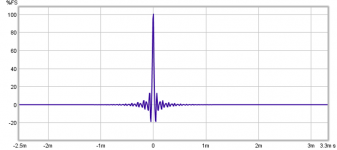
The measured impulse response is visually very close to the target set by the model:
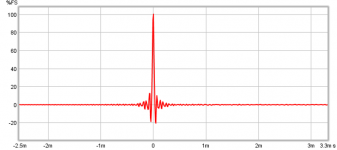
The two viewed as overlay and zoomed in amplitude:
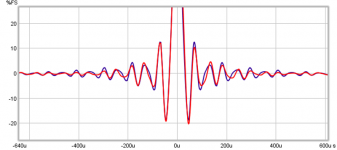
Phase is not only a very straight line, it is also very flat:
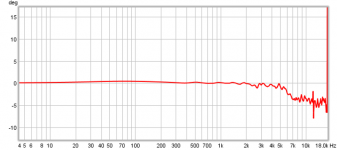
Mighty tidy. What's it do for the listening experience? Imaging is super, and stable. Instruments and voices are clear and concise. Space between instruments and voices is quiet.
But how much more so than with same speakers implemented with causal filters as found with standard active crossovers? Linear system is better, it can be driven harder before spacial attributes of clarity and darkness suffer.
Speaker is two way, 5.25" woofer, and 2" wideband as tweeter with crossover at 1kHz, driver centers are about 3" apart, roughly 1/4 wavelength of the crossover frequency.
Single greatest variable in linear phase speaker as implemented above differing from standard speakers that impacts power handling related degradation to clarity and darkness between instruments and notes is crossover slope.
At 1kHz crossover linear phase filter using FIR enables >200dB/Octave crossover. Using Butterworth filter and time reversal with convolution linear phase Linkwitz-Riley 24dB/octave crossover filters were constructed and substituted for steep FIR filters. Result was reduction in spacial performance to that of standard LR 24dB/octave crossover filters.
Similarly, extending roll off woofer highpass filter using shallower slopes reduced power levels at which clarity and spacial performance suffered.
Narrow band bursts spanning <1/2 octave to 2 octave used alone and in conjunction were used to probe both harmonic distortion and intermodulation distortion at various power levels throughout the drivers bandwidths. Above moderate power levels, both types of distortion were seen to grow rapidly. Clarity and spacial darkness decrease with increasing power levels that correlate directly to nonlinear distortion components increasing with bandwidth demand.
- Status
- Not open for further replies.
- Home
- Loudspeakers
- Multi-Way
- Speaker Clarity as "Darkness" - please chime in
